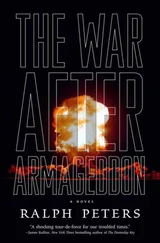“Each time Zakayev launched an operation, he did the unexpected. And I told you before, some people say he had help from the Americans, to keep Russia weak and off balance in Chechnya while the U.S. invaded the Middle East. Zakayev is experienced and he’s tough. And he’s committed to the cause.”
“But he’s not invincible,” Scott said, studying Abakov’s weary face.
“No, he’s not invincible. No man is.”
The wardroom phone chirped. Scott grabbed it from the cradle on the bulkhead and heard Botkin say, “Captain Scott, Communications is picking up another ZEVS transmission from Archangel.”
Alex and Abakov followed Scott to the radio room forward of the CCP, where a warrant officer ensconced in a small, hot cubical lined with radio and coding equipment sat hunched over his receivers.
“Definitely incoming from NorFleet” Botkin said. “We’ve received D for Delta.”
They hung outside the radio room while the rest of the K-480’s call sign, F for Foxtrot and R for Romeo, arrived and scrolled out of the printer. Z for Zulu tacked on at the end of the transmission confirmed that the message had been sent from the Russian ZEVS transmitter in Archangel, and that a burst transmission with important information had been stored for retrieval from a Molniya-3 satellite.
Alex went on ahead to the CCP, and when Scott caught up to her, he saw she was troubled.
“What’s wrong?” he asked.
“I was thinking…that Chechen girl Yuri told us about…”
“What about her?”
“How did she end up on a Russian submarine with Zakayev and Litvanov? She’s just a kid.”
“She’s also a terrorist,” Scott said, his voice low so the others couldn’t hear.
“She was turned into a terrorist, you mean. By the Russians. Maybe by us.” She looked intently at Scott, his face slightly haggard in the harsh overhead lighting in the CCP. “Imagine growing up in a country where you have to kill to stay alive. And then pledging your life to a terrorist like Zakayev.”
“It depends what side of the fence you’re on. Zakayev is a hero to her and the Chechens. Obviously Washington discovered that his brand of terrorism suited their needs. Until now.”
“In other words, realpolitik dictates the morality of your position.”
They had entered a world where there were no clear-cut answers. It was the same world Frank Drummond had inhabited, and where he had ended up dead. To Scott, unlike Alex, the girl on board the K-363 was only an abstract concept and no less dangerous for it. What wasn’t abstract was the possibility that Zakayev, with or without her help, might blow St. Petersburg to hell.
Alex waited for him to respond to what she’d said.
“Yes,” he said.
“Message for you, Captain Scott.” Botkin had a decrypted printout.
After Scott read the message, he announced to Alex and Yuri Abakov, who had joined them in the CCP, “It’s from Admiral Grishkov in Severomorsk. He says that all the SS-N-21 cruise missiles and nuclear torpedo war heads have been accounted for. He states categorically that there are none aboard the K- 363.”
Alex said, “Then that changes everything.”
“The bastards have deployed their towed sonar arrays. Listen to them.”
Litvanov snapped on a speaker. The K-363’s exceptionally sensitive MGK-503 sonar had captured not only the kish-kish-kish-kish of props but the overlaying and sibilant shhh-shhh-shhh of the towed body receptor.
“It’s at the end of a cable attached to a crane and hydraulic winch mounted on the frigate’s fantail. Very complicated.”
“Can they hear us?” Zakayev asked.
“Depends. Those arrays aren’t affected by noise from the towing ship, and they have long detection ranges. But the array flexes as it’s towed through the water and can give false contacts.” Litvanov snapped off the speaker. A tomblike silence returned to the CCP. “Also, it’s very hard to locate a quiet- running submarine in littoral waters: too many bottom anomalies and background noises to sort out.”
Litvanov studied the track of the two Norwegian frigates as it developed and was marked by Veroshilov in grease pencil on the chart overlay. The frigates had cleared the tip of Lofoten and turned northeast.
“Sonar, report,” Litvanov ordered.
“Contacts bearing one-one-zero.”
“Base course?”
A hesitation, then: “Zero-five-two, Kapitan.”
“Steer two-two-zero,” Litvanov ordered.
The K-363 turned slowly right onto an approximate reciprocal of the course steered by the two frigates. “Fire Control, can you estimate their separation?”
“Yes, Kapitan…approximately six thousand meters, staggered forty-five.”
“Starpom, sounding?”
Veroshilov sweated heavily. “Chart soundings only, Kapitan….”
“I know that, damnit.”
“Thirty-six meters and shelving.”
Litvanov spoke to Zakayev. “The Norwegians are steaming in a forty-five-degree formation, the seaward frigate out ahead. I think perhaps they are chasing ghosts, not us. If we ease on by them and they don’t react, we’re clear.”
“We are in very shallow water, eh?” Zakayev said.
“Yes. Our charts are not up to date and it’s risky to drive in so close to the beach, but that’s what will make it hard for them to find us.”
“And if we run aground?” Zakayev said.
Litvanov pretended that he didn’t hear him.
The chairman of the Joint Chiefs, Jack Webster, at the Pentagon, and ComSubLant Carter Ellsworth, in Norfolk, appeared on the video monitor’s split screen.
Paul Friedman said, “Morning, gentlemen.” Then: “Admiral, Webster, care to comment on the latest Russian communiqué?”
“We dodged a bullet. The Russians too. That Akula up in the Barents Sea is essentially toothless. Sure, she’s armed with torpedoes, but they can’t hurt us. Now it’s up to Russian NorFleet to find her and decide what they want to do.”
“Admiral Ellsworth?” said Friedman.
“I agree: There’s nothing Litvanov and the terrorists can do. Maybe threaten a few merchant vessels, give the Russians a good workout, but that’s about all. I really don’t see what they hope to accomplish. As Jack said, they’re toothless.”
“Admiral Webster, you have no doubts that the cruise missiles are all accounted for?” Radford asked.
“Yes, sir, I’m satisfied that they are. I spoke to Grishkov—Carter and I both did—and he was totally forthcoming about the storage and securing of their SSN-21s, and nuke warheads for their torpedoes.”
Ellsworth said, “Grishkov’s report on their missile inventories included the individual weapon serial numbers and chain-of-custody documents.”
“Their record-keeping isn’t as sophisticated as ours,” Webster said, “but there’s no reason to doubt them. After all, they’ve got as much at stake in this as we do.”
Radford said, “Jack, what’s the current Russian deployment look like?”
The monitor screen went to blue, then to a full-color large-scale trapezoidal view of the northern Atlantic region, the Barents Sea, and most of eastern Europe. Red deltas representing Russian ASW forces were scattered like confetti in the Barents Sea.
“As you can see, General, Russian ASW forces are deploying from northern bases into the Barents Sea.
The graphic changed to an enlargement, the red deltas organized in a drooping semicircle from Spits bergen to Novaya Zemlya.
“The Russians are trying to put a noose around the K-363 and pull it tight,” Webster said. “They’re not deployed as efficiently as they could be, but I think they stand a better than even chance of finding that sub. Mind, it’ll be like cornering an animal who doesn’t want to be captured, so don’t be surprised if Litvanov strikes first. If he does, the Russians will have a good idea where he is and then can go to work on him.”
Читать дальше












